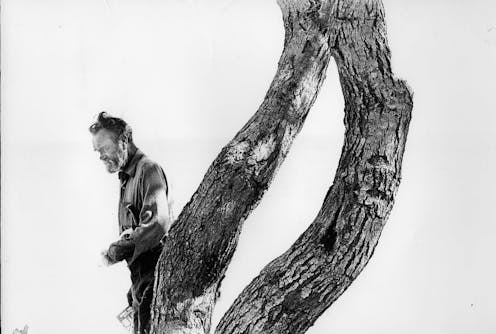A new study of artist Ian Fairweather considers how Chinese ideas influenced this wanderer and adventurer
- Written by Joanna Mendelssohn, Principal Fellow (Hon), Victorian College of the Arts, University of Melbourne. Editor in Chief, Design and Art of Australia Online, The University of Melbourne

Review: Fairweather and China, by Claire Roberts (Miegunyah Press)
Paintings by Ian Fairweather have been a part of every survey exhibition of Australian art since the Whitechapel exhibition of 1961. He is discussed as a major figure in each analysis of Australian art history since Bernard Smith’s Australian Painting of 1962. His paintings are collected in the National Gallery of Australia, all state art galleries and some regional centres. He has been the subject of a monograph by Murray Bail as well as the subject of several significant survey exhibitions.
Yet the conclusion Claire Roberts draws in this scrupulously researched examination of Fairweather’s art and ideas is he cannot be described as an Australian artist. This is not just because of Australia’s bad habit of claiming anyone who spends some time here as one of our own.
Fairweather, who was born in Scotland and raised on the Island of Jersey, first visited Australia in the 1930s and 40s, but in the 1950s he built a shack on Queensland’s Bribie Island where he lived and painted until his death in 1974.
Fairweather and Chinese art
Roberts’ earlier book on Fairweather, Ian Fairweather: A life in letters, co-written with John Thompson, is the background research for this study of the artist’s life, relationships & constant questing for meaning. Other important sources include the books he read and valued throughout his life.
What distinguishes this from any previous study of Fairweather is her scholarship in both Mandarin and contemporary art. As a result, Roberts is uniquely placed to examine Fairweather’s work in the context of his idiosyncratic understanding of Chinese literature and classical language.
The significance of Roberts’ Mandarin scholarship comes to the fore in her analysis of The Drunken Buddha (1965), Fairweather’s magnificently illustrated “free” translation of The Complete Biography of the Great Master Chi-tien (Jidian).
She notes that while many reviewers called this a significant scholarly work, it is better described as an exercise in creative exploration, in her own words “a summative significance for an understanding of Fairweather’s artistic practice”.
Ian Fairweather first visited China in 1929. He left for the last time in the face of the impending war with Japan in 1936. Nevertheless Chinese ideas, especially Taoism and Buddhism, continued to influence his art for the rest of his life.
Read more: How the stunning abstract art of Hilma af Klint opens our eyes to new ways of seeing
An artist who belongs to no nation
Fairweather is probably best described as an itinerant British wanderer in the colonial tradition of the old Empire. When the Art Gallery of South Australia asked him to nominate the artist who most influenced him, he claimed to be “a disciple of Turner”, that most English of all 19th century artists.
His life bears all the marks, or scars, of the British Empire. He was born in Scotland, the ninth son of a doctor in the Indian Medical Service. When he was six-months-old his parents returned to India, leaving the baby in the care of a great-aunt. He did not see his parents for the next ten years. Duty and family expectations saw him join the British Army, but in 1914 he was captured by the Germans and became a prisoner of war.
It was in the library of a PoW camp he first encountered books on Chinese and Japanese art. After the war he studied art at the Slade under Henry Tonks, and then wandered — to Canada, China, Bali, Australia, the Philippines, India.
Throughout his life Fairweather seemed to take lunatic risks with his personal safety, but was always saved by chance. He found his eventual home of Bribie Island 1948 by accident when his ramshackle sailing boat crash-landed him there, but did not return until after his most famous misadventure.
That was in 1952 when he tried to sail north-west from Darwin in a homemade raft and was lost at sea. Most accounts of Fairweather’s life give substantial detail to this voyage, but Roberts summarises it in a single paragraph. There is no need to walk in paths well trod.
Her conclusion is Fairweather was an artist who belonged to no nation but took his own path, wandering for truth. What that truth may be is woven through the text – in the description of the young man caught in an avalanche in Switzerland and feeling at one with the mountains, of the sailor wanting to be with the sea, and the old man exposed to the elements, living on an island off the Queensland coast.
One of Fairweather’s most loved books was Laurence Binyon’s The Flight of the Dragon: an Essay on the Theory and Practice of Art in China and Japan, based on Original Sources (1914). Binyon wrote:
The artist must pierce beneath the mere aspect of the world to seize and himself be possessed by that great cosmic rhythm of the spirit which sets the currents of life in motion".
I strongly suspect Fairweather would have regarded the idea of claiming his art as belonging to any one country or style as an irrelevancy.
Fairweather and China will be launched at the Art Gallery of South Australia, on Friday 1 October at 6 pm
Authors: Joanna Mendelssohn, Principal Fellow (Hon), Victorian College of the Arts, University of Melbourne. Editor in Chief, Design and Art of Australia Online, The University of Melbourne





